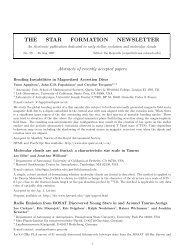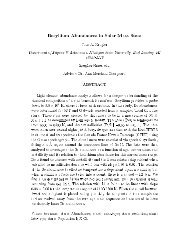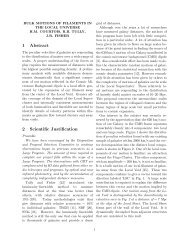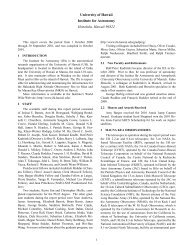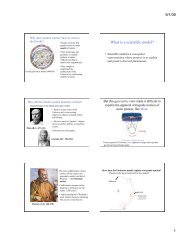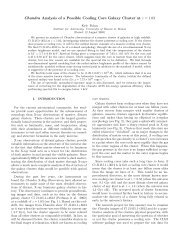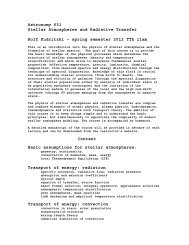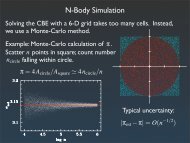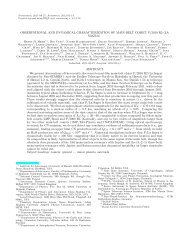Life as a Low-Mass Star What are the life stages of a low mass star?
Life as a Low-Mass Star What are the life stages of a low mass star?
Life as a Low-Mass Star What are the life stages of a low mass star?
Create successful ePaper yourself
Turn your PDF publications into a flip-book with our unique Google optimized e-Paper software.
<strong>Life</strong> <strong>as</strong> a <strong>Low</strong>-M<strong>as</strong>s <strong>Star</strong><br />
<strong>What</strong> <strong>are</strong> <strong>the</strong> <strong>life</strong> <strong>stages</strong> <strong>of</strong> a <strong>low</strong><br />
m<strong>as</strong>s <strong>star</strong>?<br />
High-M<strong>as</strong>s <strong>Star</strong>s<br />
(> 8 M Sun )<br />
Intermediate-<br />
M<strong>as</strong>s <strong>Star</strong>s<br />
<strong>Low</strong>-M<strong>as</strong>s <strong>Star</strong>s<br />
(< 2 M Sun )<br />
A <strong>star</strong> remains<br />
on <strong>the</strong> main<br />
sequence <strong>as</strong> long<br />
<strong>as</strong> it can fuse<br />
hydrogen into<br />
helium in its<br />
core.<br />
Brown Dwarfs<br />
Thought Question<br />
<strong>What</strong> happens when a <strong>star</strong> can no longer fuse<br />
hydrogen to helium in its core?<br />
A. Core cools <strong>of</strong>f.<br />
B. Core shrinks and heats up.<br />
C. Core expands and heats up.<br />
D. Helium fusion immediately begins.<br />
Thought Question<br />
<strong>What</strong> happens when a <strong>star</strong> can no longer fuse<br />
hydrogen to helium in its core?<br />
A. Core cools <strong>of</strong>f.<br />
B. Core shrinks and heats up.<br />
C. Core expands and heats up.<br />
D. Helium fusion immediately begins.<br />
1
Thought Question<br />
Helium fusion requires higher temperatures (around 100<br />
million Kelvin) than hydrogen fusion, because larger charge<br />
leads to greater electromagnetic repulsion.<br />
Fusion <strong>of</strong> two helium nuclei does not work, so helium fusion<br />
must combine three He nuclei to make carbon.<br />
<strong>What</strong> happens <strong>as</strong> a <strong>star</strong>’s inert helium core <strong>star</strong>ts<br />
to shrink?<br />
A. Hydrogen fuses in shell around core.<br />
B. Helium fusion s<strong>low</strong>ly begins.<br />
C. Helium fusion rate rapidly rises.<br />
D. Core pressure sharply drops.<br />
Thought Question<br />
<strong>What</strong> happens <strong>as</strong> a <strong>star</strong>’s inert helium core <strong>star</strong>ts<br />
to shrink?<br />
A. Hydrogen fuses in shell around core.<br />
B. Helium fusion s<strong>low</strong>ly begins.<br />
C. Helium fusion rate rapidly rises.<br />
D. Core pressure sharply drops.<br />
Broken <strong>the</strong>rmostat: rising fusion rate in shell does not<br />
expand core, so <strong>star</strong>’s luminosity continues to rise.<br />
Thought Question<br />
<strong>What</strong> happens in a <strong>low</strong>-m<strong>as</strong>s <strong>star</strong> when core temperature<br />
rises enough for helium fusion to begin?<br />
A. Helium fusion s<strong>low</strong>ly <strong>star</strong>ts up.<br />
B. Hydrogen fusion stops.<br />
C. Helium fusion rises very sharply.<br />
Thought Question<br />
<strong>What</strong> happens in a <strong>low</strong>-m<strong>as</strong>s <strong>star</strong> when core temperature<br />
rises enough for helium fusion to begin?<br />
A. Helium fusion s<strong>low</strong>ly <strong>star</strong>ts up.<br />
B. Hydrogen fusion stops.<br />
C. Helium fusion rises very sharply.<br />
Hint: Degeneracy pressure is <strong>the</strong> main form <strong>of</strong> pressure in<br />
<strong>the</strong> inert helium core.<br />
2
Helium Fl<strong>as</strong>h<br />
• Thermostat is broken in <strong>low</strong>-m<strong>as</strong>s red giant,<br />
because degeneracy pressure supports core.<br />
• Core temperature rises rapidly when helium fusion<br />
begins.<br />
• Helium fusion rate skyrockets until <strong>the</strong>rmal<br />
pressure takes over and expands core again.<br />
Helium burning <strong>star</strong>s nei<strong>the</strong>r shrink nor grow,<br />
because <strong>the</strong>rmostat is temporarily fixed.<br />
Thought Question<br />
<strong>What</strong> happens when <strong>the</strong> <strong>star</strong>’s core runs out <strong>of</strong><br />
helium?<br />
A. The <strong>star</strong> explodes.<br />
B. Carbon fusion begins.<br />
C. The core cools <strong>of</strong>f.<br />
D. Helium fuses in a shell around <strong>the</strong> core.<br />
Thought Question<br />
<strong>What</strong> happens when <strong>the</strong> <strong>star</strong>’s core runs out <strong>of</strong><br />
helium?<br />
A. The <strong>star</strong> explodes.<br />
B. Carbon fusion begins.<br />
C. The core cools <strong>of</strong>f.<br />
D. Helium fuses in a shell around <strong>the</strong> core.<br />
How does a <strong>low</strong> m<strong>as</strong>s <strong>star</strong> die?<br />
A <strong>star</strong> like our<br />
Sun dies by<br />
puffing <strong>of</strong>f its<br />
outer layers,<br />
creating a<br />
planetary nebula.<br />
Only a white<br />
dwarf is left<br />
behind.<br />
3
A <strong>star</strong> like our<br />
Sun dies by<br />
puffing <strong>of</strong>f its<br />
outer layers,<br />
creating a<br />
planetary nebula.<br />
A <strong>star</strong> like our<br />
Sun dies by<br />
puffing <strong>of</strong>f its<br />
outer layers,<br />
creating a<br />
planetary nebula.<br />
Only a white<br />
dwarf is left<br />
behind.<br />
Only a white<br />
dwarf is left<br />
behind.<br />
A <strong>star</strong> like our<br />
Sun dies by<br />
puffing <strong>of</strong>f its<br />
outer layers,<br />
creating a<br />
planetary nebula.<br />
Only a white<br />
dwarf is left<br />
behind.<br />
Evolutionary track <strong>of</strong> a <strong>low</strong>-m<strong>as</strong>s <strong>star</strong> on <strong>the</strong> H-R diagram.<br />
<strong>Life</strong> <strong>as</strong> a High-M<strong>as</strong>s <strong>Star</strong><br />
<strong>What</strong> <strong>are</strong> <strong>the</strong> <strong>life</strong> <strong>stages</strong> <strong>of</strong> a<br />
high-m<strong>as</strong>s <strong>star</strong>?<br />
4
High-M<strong>as</strong>s <strong>Star</strong>s<br />
(> 8 M Sun )<br />
Intermediate-<br />
M<strong>as</strong>s <strong>Star</strong>s<br />
<strong>Low</strong>-M<strong>as</strong>s <strong>Star</strong>s<br />
(< 2 M Sun )<br />
Brown Dwarfs<br />
High-M<strong>as</strong>s <strong>Star</strong>’s <strong>Life</strong><br />
Early <strong>stages</strong> <strong>are</strong> similar to those <strong>of</strong> <strong>low</strong>-m<strong>as</strong>s <strong>star</strong>:<br />
• Main Sequence: H fuses to He in core (CNO cycle)<br />
• Red Supergiant: H fuses to He in shell around inert<br />
He core<br />
• Helium Core Burning: He fuses to C in core (no<br />
helium fl<strong>as</strong>h)<br />
CNO cycle is just ano<strong>the</strong>r<br />
way to fuse H into He,<br />
using carbon, nitrogen, and<br />
oxygen <strong>as</strong> catalysts.<br />
CNO cycle is <strong>the</strong> main<br />
mechanism for H fusion in<br />
high-m<strong>as</strong>s <strong>star</strong>s (>2 M Sun ),<br />
because core temperature is<br />
higher.<br />
High-m<strong>as</strong>s <strong>star</strong>s<br />
become supergiants<br />
after core H runs<br />
out.<br />
Luminosity does<br />
not change much,<br />
but radius gets far<br />
larger!<br />
How do high-m<strong>as</strong>s <strong>star</strong>s make <strong>the</strong><br />
elements necessary<br />
for <strong>life</strong>?<br />
5
Big Bang made 75% H, 25% He – <strong>star</strong>s make everything else!<br />
Helium fusion can make carbon in <strong>low</strong>-m<strong>as</strong>s <strong>star</strong>s.<br />
Helium-capture reactions add two protons at a time.<br />
CNO cycle can change C into N and O.<br />
Advanced nuclear fusion reactions require extremely high<br />
temperatures.<br />
Helium-capture reactions build C into O, Ne, Mg, etc.<br />
Only high-m<strong>as</strong>s <strong>star</strong>s can attain high enough core temperatures<br />
before degeneracy pressure stops gravitational contraction.<br />
6
Advanced reactions make heavier elements<br />
in high-m<strong>as</strong>s <strong>star</strong>s.<br />
Advanced nuclear burning occurs in multiple shells.<br />
Iron is a dead<br />
end for fusion,<br />
because nuclear<br />
reactions<br />
involving iron do<br />
not rele<strong>as</strong>e<br />
energy.<br />
Evidence for heliumcapture<br />
reactions:<br />
Higher abundances <strong>of</strong><br />
elements with even<br />
numbers <strong>of</strong> protons.<br />
Fe h<strong>as</strong> <strong>the</strong> <strong>low</strong>est<br />
m<strong>as</strong>s per nuclear<br />
particle.<br />
How does a high-m<strong>as</strong>s <strong>star</strong> die?<br />
Fe builds up in core<br />
until degeneracy pressure<br />
can no longer resist<br />
gravity.<br />
Core <strong>the</strong>n suddenly<br />
collapses, creating<br />
supernova explosion.<br />
7
Core degeneracy<br />
pressure goes away,<br />
because electrons<br />
combine with<br />
protons, making<br />
neutrons and neutrinos.<br />
Neutrons collapse to<br />
<strong>the</strong> center, forming a<br />
neutron <strong>star</strong>.<br />
Energy and neutrons produced in supernova explosion<br />
enable elements heavier than Fe to form.<br />
Elements made<br />
during supernova<br />
explosion<br />
Crab Nebula: Remnant <strong>of</strong> supernova observed in 1054 A.D.<br />
The next<br />
nearby<br />
supernova?<br />
before<br />
after<br />
Supernova 1987A is <strong>the</strong> ne<strong>are</strong>st supernova<br />
observed in <strong>the</strong> l<strong>as</strong>t 400 years.<br />
8
<strong>Low</strong>-M<strong>as</strong>s <strong>Star</strong> Summary<br />
1. Main Sequence: H fuses to He<br />
in core.<br />
How does a <strong>star</strong>’s m<strong>as</strong>s<br />
determine its <strong>life</strong> story?<br />
2. Red Giant: H fuses to He in<br />
shell around He core.<br />
3. Helium Core Burning:<br />
He fuses to C in core while H<br />
fuses to He in shell.<br />
4. Double-Shell Burning:<br />
H and He both fuse in shells.<br />
Not to scale!<br />
5. Planetary Nebula leaves white<br />
dwarf behind.<br />
Re<strong>as</strong>ons for <strong>Life</strong> Stages<br />
<strong>Life</strong> Stages <strong>of</strong> High-M<strong>as</strong>s <strong>Star</strong><br />
Core shrinks and heats until it’s<br />
hot enough for fusion.<br />
1. Main Sequence: H fuses to He in<br />
core<br />
Nuclei with larger charge require<br />
higher temperature for fusion.<br />
2. Red Supergiant: H fuses to He in<br />
shell around He core<br />
Core <strong>the</strong>rmostat is broken while<br />
core is not hot enough for<br />
fusion (shell burning).<br />
3. Helium Core Burning:<br />
He fuses to C in core while H fuses<br />
to He in shell<br />
Not to scale!<br />
Core fusion can’t happen if<br />
degeneracy pressure prevents<br />
core from shrinking.<br />
Not to scale!<br />
4. Multiple-Shell Burning:<br />
Many elements fuse in shells<br />
5. Supernova leaves neutron <strong>star</strong> or<br />
black hole behind.<br />
How <strong>are</strong> <strong>the</strong> lives <strong>of</strong> <strong>star</strong>s with<br />
close companions different?<br />
<strong>Life</strong> <strong>of</strong> a 20M Sun <strong>star</strong><br />
<strong>Life</strong> <strong>of</strong> a 1M Sun <strong>star</strong><br />
9
Thought Question<br />
The binary <strong>star</strong> Algol consists <strong>of</strong> a 3.7 M Sun main<br />
sequence <strong>star</strong> and a 0.8 M Sun subgiant <strong>star</strong>.<br />
<strong>What</strong>’s strange about this pairing?<br />
How did it come about?<br />
<strong>Star</strong>s in Algol <strong>are</strong> close<br />
enough that matter can f<strong>low</strong><br />
from subgiant onto mainsequence<br />
<strong>star</strong>!<br />
> <strong>Star</strong> that is now a<br />
subgiant w<strong>as</strong> originally<br />
more m<strong>as</strong>sive.<br />
> As it reached <strong>the</strong> end <strong>of</strong><br />
its <strong>life</strong> and <strong>star</strong>ted to grow,<br />
it began to transfer m<strong>as</strong>s to<br />
its companion.<br />
> Now <strong>the</strong> companion <strong>star</strong><br />
is more m<strong>as</strong>sive.<br />
10



